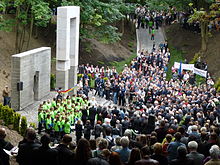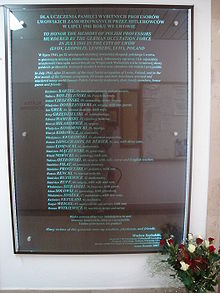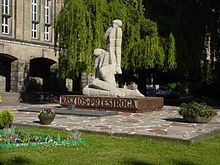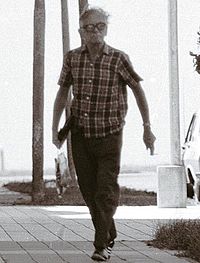- Massacre of Lviv professors
-
In July 1941, 25 Polish academics from the city of Lwów, Poland (German: Lemberg, Ukrainian: Львів (Lviv); now in Ukraine) were killed by Nazi German occupation forces along with their families and guests. By targeting prominent citizens and intellectuals for elimination, the Nazis hoped to prevent anti-Nazi activity and to weaken the resolve of the Polish resistance.
Contents
Background
Prior to September 1939 and the joint Nazi-Soviet invasion of Poland Lviv (Lwów in Polish), then in the Second Polish Republic had 318,000 inhabitants of different ethnic groups and religions, 60% of whom were Poles, 30% Jews and about 10% Ukrainians and Germans.[1] The city was one of the most important cultural centers of prewar Poland, housing 5 tertiary educational facilities including Lwów University and Lwów Polytechnic. It was the home for many Polish and Jewish intellectuals, political and cultural activists, scientists and members of Poland's interwar elite.
After Lviv was occupied by the Soviets in September 1939, Lwów University was renamed in honor of Ivan Franko, a major Ukrainian literary figure who lived in Lviv, and the language of instruction was changed from Polish to Ukrainian.[2] Lwów was then captured by German forces on June 30, 1941 after the German invasion of the Soviet Union in June 1941. Along with the German Wehrmacht units, a number of Abwehr and SS formations entered the city.
During the Nazi occupation, almost all of the 120,000 Jewish inhabitants of the city were killed, within the city's ghetto or in Bełżec extermination camp. By the end of the war, only 200-800 Jews survived.
In order to control the population, prominent citizens and intellectuals of all ethnic groups, but particularly Jews and Poles, were either closed in ghettos or transported to the execution sites such as the Gestapo prison on Pełczyńska Street, the Brygidki Prison, the former military prison at Zamarstynów and to the fields surrounding the city—in the suburb of Winniki, the Kortumówka hills and the Jewish Cemetery. Many of the people killed were prominent leaders of Polish society: politicians, artists, aristocrats, sportsmen, scientists, priests, rabbis and other intelligentsia. The mass murder of people suspected of potential anti-Nazi activity was seen as a pre-emptive measure to keep the Polish resistance scattered and to prevent the Poles from revolting against Nazi rule. It was a direct continuation of the infamous AB Action (Ausserordentliche Befriedungsaktion ) and one of the early stages of Generalplan Ost, after the German campaign against the USSR started and the eastern half of prewar Poland fell under German occupation in place of that of the Soviet Union. One of the earliest Nazi crimes in Lviv was the mass murder of Polish professors together with some of their relatives and guests, carried out at the beginning of July 1941.
History
By July 2, 1941, many of the initial terror actions were halted, yet the individual, planned executions continued. At approximately 3 o'clock in the evening Prof. Kazimierz Bartel was arrested by one of the Einsatzgruppen operating in the area.
During the night from 3 to 4 of July, several dozen professors and their families were arrested by German detachments - each one consisting of an officer, several soldiers, Ukrainian guides and interpreters.[3] The lists were prepared by their Ukrainian students[clarification needed] associated with OUN.[4][5] Some of the professors mentioned on the lists were already dead, specifically Adam Bednarski and Roman Leszczyński.[3] Among arrested was professor Roman Rencki, a director of the Clinic for Internal Diseases at Lwów University, who was kept in NKVD prison and whose name was also on the list of Soviet prisoners sentenced to death.[6][7] The detained were transported to the Abrahamowicz's dormitory, where despite the preconceived intention to kill them, they were tortured and interrogated. The head of the department in the Jewish hospital, professor Adam Ruff was shot while having an epileptic attack.[3]
In the early morning of July 4 one of the professors and most of his servants were set free while the rest were either brought to the Wulka hills or shot dead in the courtyard of the Bursa Abrahamowiczów building. The victims were buried on the spot, but several days after the massacre their bodies were exhumed and transported by the Wehrmacht to an unknown place.
According to a Polish historian the victims were not involved in politics in any way.[8] According to a Ukrainian historian, out of approximately 160 Polish professors living in Lviv in June 1941, the professors chosen for execution were specifically those who actively cooperated with the Soviet regime in some way between 1940-1941.[9]
Methods of killing
There are accounts of four different methods used by the German troops. The victims were either beaten to death, killed with a bayonet, killed with a hammer, or shot to death.
The professors themselves were shot to death, although it is highly probable that some of them were buried alive.[10]
Responsibility
According to an eyewitness the executions were made by an Einsatzgruppen unit (Einsatzkommando zur besonderen Verwendung) under the command of SS-Brigadeführer Karl Eberhard Schöngarth with the participation of Ukrainians translators, who were dressed in German uniforms.[11]
The decision was taken by the highest level of the Third Reich authorities.[12] The direct decision maker concerning the massacre was the commander of the Sicherheitspolizei (Befehlshaber der Sicherheitspolizei und des SD- BdS) in Krakau District Generalgouvernement, Brigadeführer Karl Eberhard Schöngarth. The following Gestapo officers also participated: Heinz Heim (Chief of Staff Schöngarth), Hans Krüger, Walter Kutschmann, Kurt Stawizki, and Felix Landau. They were never punished for that crime.[13] Walter Kutschmann lived under a fake identity in Argentina until January 1975, when he was found and exposed by journalist Alfredo Serra in the resort town of Miramar. He was arrested ten years later in Florida, Buenos Aires by Interpol agents, and died of myocardial infarction in jail before he could be extradited, on 30 August 1986.[14]
Some sources contend that members of the Ukrainian auxiliaries from the Nachtigall Battalion were responsible for the murders.[15] According to others, this claim originated with the Soviet sources (Soviet propaganda campaign against the Organization of Ukrainian Nationalists) and has been disputed.[16][17] Memorial has published documents which claim to document the Nachtigall participation in those events as a KGB disinformation.[18] Stanisław Bogaczewicz from the Institute of National Remembrance said that Nachtigall soldiers took part in the arrests, but not in the murders, and that their role in this event needs further investigation.[19] Tadeusz Piotrowski notes that while Nachtigall role is disputed, they were present in the town during the events, their activities are not properly documented, and that at the very least they are guilty of the passive collaboration in this event, for not opposing the atrocities.[15]
According to Lviv historian Vasyl Rasevych, the statement that Ukrainians participatied in the massacre of the Polish professors is nonsense and that no archival evidence exists regarding this.[20]
Aftermath
After World War II the leadership of the Soviet Union made attempts to diminish the Polish cultural and historic legacy of Lviv. Crimes committed east of the Curzon line could not be prosecuted by Polish courts. Information on the atrocities that took place in Lviv was restricted.
In 1960 Dr. Helena Krukowska, the widow of Prof. Dr. Włodzimierz Krukowski, launched an appeal to the court in Hamburg. After five years the German court closed the judicial proceedings. Public prosecutor von Beelow argued that the people responsible for the crime were already dead. This however was not true since at the same time SS-Hauptsturmführer Hans Krüger, commander of the Gestapo unit supervising the massacres in Lviv in 1941, was being held in Hamburg prison (he was sentenced to life imprisonment for the mass murder of Jews and Poles in Stanisławów, committed several weeks after his unit was transferred from Lviv). As a result no person has ever been held responsible for this atrocity.[13]
In the 1970s Abrahamowicz Street in Lviv was renamed Tadeusz Boy-Żeleński Street.
Various Polish organisations have made deputations to remember the victims of the atrocity with a monument or a symbolic grave in Lviv.
The case of the murder of the professors is currently under investigation by the Institute of National Remembrance.
In May 2009, the monument to the victims in Lviv was defaced with red paint bearing the words "Death to the Lachs (Poles)".[21]
On July 3, 2011 a memorial dedicated to the 39 Polish professors murdered by the Gestapo on July 4, 1941 was opened in Lviv.[20]
Victims
Abbreviations used:
- UJK = Uniwersytet Jana Kazimierza (Lwów University, now Ivan Franko National University of Lviv)
- PSP = Państwowy Szpital Powszechny (National Public Hospital)
- PL = Politechnika Lwowska (Lwów Polytechnic, now Lviv Polytechic National University)
- AWL = Akademia Weterynaryjna we Lwowie (Academy of Veterinary Sciences in Lwów)
- AHZ = Akademia Handlu Zagranicznego we Lwowie (Academy of Foreign Trade in Lwów)
Murdered on the Wulkeckie (Wulka) hills
- Prof. Dr. Antoni Cieszyński, Professor of Stomatology UJK
- Prof. Dr. Władysław Dobrzaniecki, head of the ord. Oddz. Chirurgii PSP
- Prof. Dr. Jan Grek, Professor of Internal Medicine, UJK
- Maria Grekowa, wife of Jan Grek
- Doc. Dr. Jerzy Grzędzielski, head of the Institute of Ophthalmology, UJK
- Prof. Dr. Edward Hamerski, Chief of Internal Medicine, AWL
- Prof. Dr. Henryk Hilarowicz, Professor of Surgery, UJK
- Rev. Dr. Władysław Komornicki, theologian, a relative of the Ostrowski family
- Eugeniusz Kostecki, husband of Prof. Dobrzaniecki's servant
- Prof. Dr. Włodzimierz Krukowski, Chief of the Institute of Electrical Measurement, PL
- Prof. Dr. Roman Longchamps de Bérier, Chief of the Institute of Civil Law, UJK
- Bronisław Longchamps de Bérier, son of Prof. Longchamps de Bérier
- Zygmunt Longchamps de Bérier, son of Prof. Longchamps de Bérier
- Kazimierz Longchamps de Bérier, son of Prof. Longchamps de Bérier
- Prof. Dr. Antoni Łomnicki, Chief of the Institute of Mathematics, PL
- Adam Mięsowicz, grandson of Prof. Sołowij
- Prof. Dr. Witołd Nowicki, Dean of the Faculty of Anatomy and Pathology, UJK
- Dr. Med. Jerzy Nowicki, assistant at the Institute of Hygiene, UJK, son of Prof. Nowicki
- Prof. Dr. Tadeusz Ostrowski, Chief of the Institute of Surgery, UJK
- Jadwiga Ostrowska, wife of Prof. Ostrowski
- Prof. Dr. Stanisław Pilat, Chief of the Institute of Technology of Petroleum and Natural Gases, PL
- Prof. Dr. Stanisław Progulski, pediatrician, UJK
- Andrzej Progulski, son of Prof. Progulski
- Prof. Dr. Roman Rencki, Chief of the Institute of Internal Medicine, UJK
- Dr. Med. Stanisław Ruff, Chief of the Department of Surgery of the Jewish Hospital
- Anna Ruffowa, Dr. Ruff's wife
- Inż. Adam Ruff, Dr. Ruff's son
- Prof. Dr. Włodzimierz Sieradzki, Dean of the faculty of Court Medicine, UJK
- Prof. Dr. Adam Sołowij, former Chief of the Department of Gynaecology and Obstetrics of the PSP
- Prof. Dr. Włodzimierz Stożek, Dean of the Faculty of Mathematics, PL
- Inż. Eustachy Stożek, assistant at the Politechnika Lwowska, son of Prof. Stożek
- Emanuel Stożek, son of Prof. Stożek
- Dr. Tadeusz Tapkowski, lawyer
- Prof. Dr. Kazimierz Vetulani, Dean of the Faculty of Theoretical Mechanics, PL
- Prof. Dr. Kacper Weigel, Chief of the Institute of Measures, PL
- Mgr Józef Weigel, son of Prof. Weigel
- Prof. Dr. Roman Witkiewicz, Chief of the Institute of Machinery, PL
- Prof. Dr. Tadeusz Boy-Żeleński, writer and gynaecologist, Chief of the Institute of French Literature
Murdered in the courtyard of Bursa Abrahamowiczów
Bursa Abrahamowiczów is a former school in Lviv, now a hospital.
- Katarzyna Demko, English language teacher
- Doc. Dr. Stanisław Mączewski, head of the Department of Gynaecology and Obstetrics of the PSP
- Maria Reymanowa, nurse
- Wolisch (name unknown), merchant
Murdered on July 12
- Prof. Dr. Henryk Korowicz, Chief of the Institute of Economics, AHZ
- Prof. Dr. Stanisław Ruziewicz, Chief of the Institute of Mathematics, AHZ
Murdered on July 26 in Brygidki Prison
Brygidki Prison is a prison in Lviv.
- Prof. Dr. Kazimierz Bartel, former Prime Minister of Poland, former Rector of PL, Chairman of the Department of Geometry, PL
See also
- Intelligenzaktion
- Sonderaktion Krakau
- Ponary massacre
- NKVD prisoner massacres
- Anti-Polonism
- Jakub Karol Parnas
- List of massacres
- Czarny Las Massacre
References
- ^ Mały Rocznik Statystyczny 1939 (Polish statistical yearbook of 1939), GUS, Warsaw, 1939
- ^ Roger Dale Petersen, Understanding ethnic violence: fear, hatred, and resentment in twentieth-century Eastern Europe, Cambridge University Press, 2002, p. 124
- ^ a b c Aneks do Informacji o działalności Instytutu Pamięci Narodowej - Komisji Ścigania Zbrodni przeciwko Narodowi Polskiemu od 1 stycznia do 31 grudnia 2006 r., Oddziałowa Komisja w Rzeszowie , zbrodnie nazistowskie , sygn. akt S 5/03/Zn , pp. 36-37
- ^ Zygmunt Albert Kaźń profesorów lwowskich – lipiec 1941 / studia oraz relacje i dokumenty zebrane i oprac. przez Zygmunta Alberta Wrocław 1989, Wydawnictwo Uniwersytetu Wrocławskiego, ISBN 83-229-0351-0 s. 180-181
- ^ IPN — Oddziałowa Komisja w Rzeszowie, "Śledztwo w sprawie zabójstwa profesorów polskich wyższych uczelni, członków ich rodzin oraz współmieszkańców, we Lwowie w lipcu 1941 roku, podjęte na nowo z umorzenia w dniu 25 lutego 2003 roku. sygn. S 5/03/Zn.", [1]
- ^ Grzegorz Hryciuk, Mordy w więzieniach Lwowskich w czerwcu 1941 roku, Wrocławskie studia z historii najnowszej, vol. 7, Instytut Historyczny Uniwersytetu Wrocławskiego, 1997, p. 64
- ^ When the front was approaching Lwów, the Russians shot some of the prisoners. Rencki managed to hide in the cell, and during the German bombing escaped from the prison. [in:] Wanda Wojtkiewicz-Rok, W 65. rocznicę kaźni profesorów lwowskich, Gazeta Akademii Medycznej we Wrocławiu
- ^ Jak ginęły elity Rzeczypospolitej April 23, 2007. Dziennik Polski.
- ^ І.К. Патриляк. Військова діяльність ОУН(Б) у 1940—1942 роках. — Університет імені Шевченко \Ін-т історії України НАН України Київ, 2004 I.K Patrylyak. (2004). Military activities of the OUN (B) in the years 1940-1942. Kiev, Ukraine: Shevchenko University \ Institute of History of Ukraine National Academy of Sciences of Ukraine. pg. 323
- ^ Krakowscy i wrocławscy akademicy na wzgórzach wuleckich we Lwowie, Alma Mater nr 33/2001
- ^ Zygmunt Albert, Kaźń profesorów lwowskich w lipcu 1941 roku, Warszawa 2004 (in Polish)
- ^ The decision regarding Kazimierz Bartel, former Polish Prime Minister, was taken by Heinrich Himmler.
- ^ a b Wacław Szulc Wyniki śledztwa w sprawie mordu profesorów lwowskich, prowadzonego przez Główną Komisję Badania Zbrodni Hitlerowskich w : Zygmunt Albert Kaźń profesorów lwowskich – lipiec 1941 / studia oraz relacje i dokumenty zebrane i oprac. przez Zygmunta Alberta Wrocław 1989, Wydawnictwo Uniwersytetu Wrocławskiego, ISBN 83-229-0351-0 s. 177-185.(in Polish)(main article in English,German and Russian)
- ^ Gente magazine, issue 2417 (Spanish)
- ^ a b Tadeusz Piotrowski (January 2007). Poland's holocaust: ethnic strife, collaboration with occupying forces and genocide in the Second Republic, 1918-1947. McFarland. pp. 208–211. ISBN 9780786429134. http://books.google.com/books?id=NBbnrEMswbUC&pg=PA208. Retrieved 11 March 2011.
- ^ Yuri Boshyk; Roman Waschuk; Andriy Wynnyckyj; Canadian Institute of Ukrainian Studies (1986). Ukraine during World War II: history and its aftermath: a symposium. CIUS Press. pp. 83–. ISBN 9780920862360. http://books.google.com/books?id=YMk8366ZFQcC&pg=PA83. Retrieved 11 March 2011.
- ^ Borys Lewytzkyj (1984). Politics and society in Soviet Ukraine, 1953-1980. CIUS Press. pp. 42–. ISBN 9780920862339. http://books.google.com/books?id=VTnUONGOPiQC&pg=PA42. Retrieved 11 March 2011.
- ^ [2]
- ^ Biuletyn IPN – Kaźń profesorów lwowskich w lipcu 1941 roku]
- ^ a b [3]
- ^ [4]
Further reading
- Albert, Zygmunt (1989). Kaźń profesorów lwowskich — lipiec 1941 - collection of documents. Wrocław, University of Wrocław Press. ISBN 8322903510.
- Lanckorońska, Karolina (2001). Wspomnienia wojenne. Kraków, Znak. ISBN 8324000771.
- Sterkowicz, Stanisław (1974). Tadeusz Boy-Żeleński; lekarz, pisarz, społecznik. Warsaw, PZWL.
- Szewalski, Robert (1993). Politechnika Lwowska 1844-1945. Wrocław, Wrocław University of Technology Press. ISBN 8370850588.
- (Ukrainian) Ярослав Грицак (Yaroslav Hrytsak) (1996). Формування модерної української нації XIX-XX ст. (Formation of the Modern Ukrainian Nation in the late 19th–20th centuries). Kiev: Генеза (Heneza). ISBN 966-504-150-9. Available online. Section 5.4 Between two totalitarianisms. The question of collaboration: an attempt at analysis
External links
- Murder of Lwow professors
- (Polish) report of an ongoing investigation by IPN
- (Polish) Zygmunt Albert - Mord Profesorów Lwowskich w lipcu 1941 roku
Coordinates: 49°49′42.95″N 24°00′48.45″E / 49.8285972°N 24.0134583°E
History Armenian Statute · Dormition Brotherhood · Jesuit Collegium · First Siege by Cossacks · Second Siege by Cossacks · Lwów Oath · Siege by Turks · Leopolis Triplex · Stauropegion Institute · Stauropegion Press · Ossolineum · Galician Rada · Halytsko-Ruska Matytsia · Prosvita · Ruthenian Triad · Ruthenian National House · Hutsul Secession · Batiars · Lwów Eaglets · Battle 1918 · Pogrom 1918 · Battle 1920 · Secret Ukrainian University · School of Logic · School of Mathematics · Battle 1939 · Massacre of Lviv professors · Lviv pogroms · Lemberg Ghetto · Lwów Uprising · Sknyliv airshow disaster
Religion Armenian Cathedral · Cathedral of St. George · Chapel of the Boim family · Bernardine Church · Bridgettine Convent · Carmelite Church · Convent of Benedictines · Church of St. Anne · Church of John the Baptist · Church of Mary of Snow · Church of St. Elizabeth · Church of St. Mary Magdalene · Church of St. Onuphrius · Church of the Dormition · Church of the Purification, Lviv · Church of the Transfiguration · Dominican Church · Jesuit Church · Latin Cathedral
Attractions Arena Lviv · Arsenal Museum · Bandinelli Palace · Black Kamienica · Catholic University · Cemetery of the Defenders of Lwów · Freedom Boulevard · Government House · King Cross Leopolis · Korniakt Palace · Lviv High Castle · Lviv University · Lychakivskiy Cemetery · Market Square · Mickiewicz Square · National Museum · Polytechnic University · Liubomyrsky Palace · Metropolitan Palace · Old Town · Pharmacy Museum · Pototsky Palace · Sapieha Palace · Scottish Café · Shevchenkivskyi Hai · Theatre of Opera and Ballet · Town Hall · Ukraina Stadium · Union of Lublin Mound
Transport Massacres of Polish citizens in World War II Volhynia - Dominopol
- Janowa Dolina
- Kisielin
- Kisorycze
- Kurdybań Warkowicki
- Ostrówki
- Parośla I
- Poryck
- Wola Ostrowiecka
- Żeniówka

Eastern Galicia - Chodaczków Wielki
- Huta Oleska
- Huta Pieniacka
- Korosciatyń
- Lwów
- Palikrowy
- Podkamień
Belarus Lithuania Russia Current Poland  Polish self-defence centres
Polish self-defence centres- Huta Stepańska
- Kuty (in Volhynia)
- Pańska Dolina
- Przebraże
- Stara Huta
Categories:- Einsatzgruppen
- History of Lviv
- Germany–Poland relations
- Poland–Ukraine relations
- Massacres in Poland
- Massacres in Ukraine
- Soviet–German War
- People killed by Nazi Germany
- Nazi war crimes in Poland
- 1941 in Poland
- The Holocaust in Ukraine
Wikimedia Foundation. 2010.






